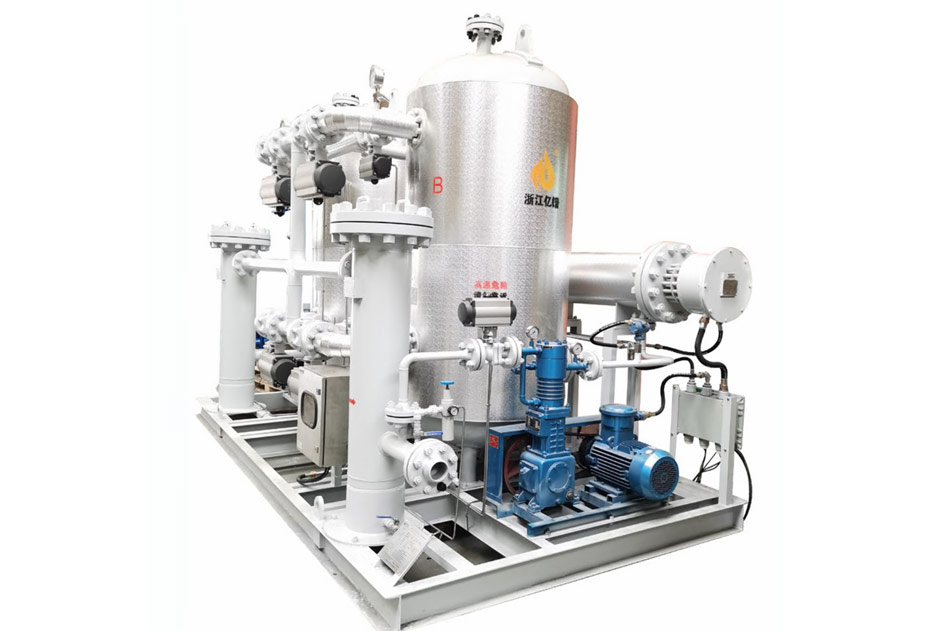Municipal Pipeline Gas Dehydration Solutions
Industry Pain Points
Pipeline Corrosion and Ice Blockage: Residual moisture in pipelines combines with acidic components (e.g., CO₂, H₂S) in natural gas to form acidic condensate, causing internal pipeline corrosion and ice blockage of pressure regulators. This increases annual maintenance costs by over 30%.
Calorific Value Fluctuations and Measurement Disputes: Moisture dilutes the calorific value of natural gas—each 1% volume of moisture reduces the calorific value by 0.5%—triggering calorific value complaints from end-users. Annual losses from measurement disputes exceed 10 million yuan.
Pressure Regulator Failure: In low winter temperatures, condensed water in pipelines freezes and causes frost cracking of regulator diaphragms, leading to gas supply interruptions. The average annual failure rate is ≥15 times per 1,000 km of pipeline.
Limitations of Traditional Dehydration Technologies: Triethylene glycol (TEG) dehydration systems require continuous power supply and pose a risk of benzene-series compound emissions; adsorbent desiccants need frequent replacement (every 6-12 months), resulting in high operation and maintenance (O&M) costs.
System Overview
Through the “gravity separation – pressure energy refrigeration – intelligent adsorption” technology chain, Yipu Urban Pipeline Gas Dehydration System achieves:
- Intrinsic Safety: No electricity or chemicals involved, completely eliminating explosion risks.
- Economic Efficiency: Comprehensive costs over 5 years are 70% lower than TEG systems, with an investment payback period of <1.5 years.
- Digital Empowerment: The AI ice blockage prediction system provides early warnings 72 hours in advance, ensuring winter gas supply.
Technological Evolution:
- Launched a hydrogen-compatible dehydrator in 2024, suitable for future hydrogen-blended pipelines (H₂ ≤20%).
- Developed a pipeline-embedded micro dehydration unit, directly deployable in medium-pressure branch lines.
This solution is a strategic choice for urban gas companies to achieve “zero-corrosion pipelines” and “smart gas”.
Solution Approach
Yipu Urban Pipeline Gas Dehydration Solution
| Module | Technical Highlights | Performance Parameters |
|---|---|---|
| Pre-Filtration Unit | Sintered metal filter element (5μm) + explosion-proof electric tracing | Particles ≤1mg/m³, adapts to -30℃ low temperature |
| Condensation Dehydration Module | Pressure energy refrigeration + frequency conversion control, dew point -10℃ | Energy consumption: 0kWh, pressure loss ≤0.01MPa |
| Adsorption Drying Tower | Dual-tower design, molecular sieve service life ≥5 years | Outlet dew point -40℃, adapts to ±5% flow fluctuation |
| Intelligent Control System | IoT (NB-IoT) remote monitoring, AI predicts ice blockage risks | Fault early warning accuracy ≥95% |
| Environmental Protection Drainage System | Condensed water with COD ≤30mg/L, directly discharged into municipal pipelines | Complies with GB/T 31962-2015 standard |
Applicable Scenarios:
- Dehydration before pressure regulation at urban gate stations
- Regional pipeline network hubs
- Pre-purification at LNG/CNG refueling stations
Technical Principles
Yipu Shale Gas Dehydration Four-Stage Process:
- Cyclonic Liquid Removal (Stage 1):The axial hypergravity separator removes over 90% of free water within 0.3 seconds, with mineralization resistance up to 50g/L.
- Precooling and Dehumidification (Stage 2):Adopts ejector refrigeration (driven by wellhead pressure energy) to cool the gas from 45℃ to 10℃ without electricity consumption, reducing the dew point to -5℃.
- Composite Adsorption (Stage 3):Hydrophobic silica gel-molecular sieve composite bed:
- Silica gel prioritizes the adsorption of organic sulfur (methyl mercaptan removal rate ≥95%)
- Molecular sieve (patented 3A-STM model) achieves deep dehydration to -60℃
- Intelligent Regeneration (Stage 4):Low-pressure steam (0.8MPa) and shale gas self-circulation regeneration reduce energy consumption by 70% compared with traditional electric heating.
Core Advantage
| Advantage | Details |
|---|---|
| Customized on Demand | Meets special working conditions; provides professional non-standard customization |
| Low Cost | Adopts cyclic regeneration process; significantly reduces operating costs |
| High Stability | Dual-tower structure with small pressure fluctuation; low noise and continuous gas supply |
| Fully Automatic Operation | Easy to operate, reducing labor input; improves efficiency |
| High Safety | Presets multi-level safety protection measures; supports automatic alarm |
| Low Failure Rate | Maintains low failure rate after 10,000 hours; high durability with almost no maintenance required |
Technical Strength
Leading Adsorption Dehydration Technology
Uses high-performance molecular sieve adsorbents with high water absorption capacity and resistance to corrosion by acidic gases (H₂S/CO₂), ensuring deep dehydration with a dew point ≤-70℃.
The original hot nitrogen regeneration process reduces energy consumption by 30% compared with traditional electric heating regeneration, and integrates a waste heat recovery system to significantly improve energy efficiency.
Modular and Customized Design Capability
Core equipment adopts modular prefabrication, supporting rapid deployment (installation cycle shortened by 50%) and adapting to diverse scenarios such as offshore platforms, onshore gas fields, and LNG pretreatment.
Can customize single-tower, dual-tower, or multi-tower parallel systems according to customer needs, with a treatment capacity ranging from 10,000 to 1,000,000 Nm³/d, flexibly matching gas fields of different scales.
Intelligent Control and Remote Operation & Maintenance
Equipped with a PLC+IoT intelligent control system, it real-time monitors key parameters such as pressure, temperature, and dew point, supporting fault early warning and automatic adjustment.
Through cloud-based big data analysis, it optimizes the adsorption-regeneration cycle, extends the service life of molecular sieves, and reduces O&M costs by 10%-15%.
Energy-Saving and Environmental Protection Technology
Features zero-emission design for regeneration exhaust gas, complying with international environmental standards such as EU CE and US EPA.
Energy consumption is 25%-40% lower than that of traditional triethylene glycol (TEG) dehydration systems, helping customers achieve carbon emission reduction goals.
Long-Cycle Operation Reliability
Molecular sieves adopt anti-pulverization coating technology, with a service life of over 5 years, reducing replacement frequency.
Key components (e.g., valves, instruments) are selected from international first-tier brands (e.g., Siemens, Emerson), with a Mean Time Between Failures (MTBF) of over 100,000 hours.
Strong R&D and Engineering Experience
Possesses more than 19 patents and software copyrights in dehydration technology; the R&D team is led by doctors and has in-depth cooperation with universities and colleges.
Has over 1,000 successful cases worldwide, covering extreme working conditions such as high-sulfur gas fields in the Middle East and low-temperature environments in the Arctic.
Product Advantage Comparison
| Indicator | Yipu System | TEG Dehydration | Refrigeration Method | Competitor Adsorption Systems |
|---|---|---|---|---|
| Dew Point | -40℃ (scalable to -60℃) | -25℃ (requires deep regeneration) | -15℃ | -35℃ (2 replacements per year) |
| Sulfur Resistance | Methyl mercaptan ≤5ppm | Requires pre-installed desulfurization device | Not applicable | Adsorbent service life ≤2 years |
| Energy Consumption | 0kWh (fully pressure energy-driven) | 0.15kWh/m³ | 0.1kWh/m³ | 0.05kWh/m³ |
| O&M Cost | <0.01 RMB/m³ (no replacement for 5 years) | 0.08 RMB/m³ (TEG + electricity cost) | 0.06 RMB/m³ (mainly electricity cost) | 0.12 RMB/m³ (consumables) |
| Environmental Friendliness | Zero chemicals, zero VOCs emissions | Risk of benzene-series compound emissions | Potential refrigerant leakage | Difficult molecular sieve waste disposal |
| Pressure Adaptability | 0.2-1.2MPa without adjustment loss | Requires stable pressure | Requires stable pressure | Optimal at 0.3-0.8MPa |
Typical Case
Project Name: Gas Pipeline Network Renovation in a Provincial Capital City in North China
Operating Conditions:
- Treatment Capacity: 500,000 Nm³/day, pressure fluctuating between 0.4-0.7MPa
- Gas Quality: CO₂ 2.5%, H₂S 5ppm, water-saturated
Dehydration Effect:
- Dew point stably reduced from +20℃ to -45℃
- Annual pipeline corrosion rate decreased by 82%, pressure regulator failures reduced to zero
Economic Benefits:
- Reduced annual maintenance costs by 18 million RMB
- Calorific value complaint rate decreased by 95%, recovering 5 million RMB in annual measurement losses

